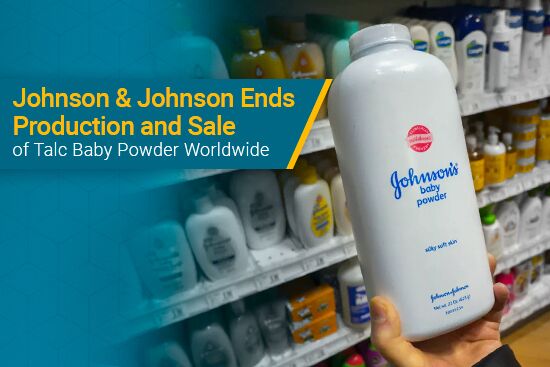Talc itself is not banned, but the use of talc in certain products such as baby powder has been significantly reduced due to concerns that it may be contaminated with asbestos, which is a known carcinogen and can cause mesothelioma. Asbestos can be found in nature near talc deposits and can contaminate talc during the mining process. This has led to lawsuits against companies such as Johnson & Johnson who have been accused of knowing about the risk of asbestos contamination in their talc-based products but failing to warn consumers.
Estimated Read Time: 4 minutes
More than two years after Johnson & Johnson stopped manufacturing and selling its talc Johnson & Johnson Baby Powder product in North America, the health and beauty giant decided to put an end to the talcum powder worldwide.
Media outlets, including from the New York Times, reported Johnson & Johnson Baby Powder is coming to a close soon. The company announced it will completely phase out all manufacturing of talc-based baby powder by 2023.
Johnson & Johnson has unveiled Vivvi & Bloom, a cornstarch-based baby powder brand that was announced last month. The cornstarch version of the company’s baby powder will be what is manufactured, advertised, and sold worldwide starting in 2023 – not just in North America. This decision will improve consumer safety in Asia, Africa, South America and other international markets.
Why Johnson & Johnson Baby Powder Is Not Safe
Johnson & Johnson Baby Powder is the source of tens of thousands of cancer lawsuits due to it not being safe to use. Most of these cases are ovarian cancer, lung cancer, or the rare cancer called mesothelioma. The scientific link between the product and cancer is the ingredient talc.
Talc is a natural mineral that absorbs moisture and keeps skin healthy. It also is found near asbestos, another mineral. Asbestos was used for decades – and even centuries – to strengthen offices, homes, entertainment venues and more buildings. Asbestos resists fire and is durable for building structure, so it was used in insulation, ceiling tiles and floor tiles, around electrical wiring, and more.
In the 1980s, the public learned asbestos could cause cancer if it was swallowed or inhaled. Small fragments of asbestos rocks could splinter off and float in the air undetected. Anyone who worked with asbestos on construction sites or who lived or worked in buildings made with asbestos were at risk of exposure.
Asbestos can also contaminate talcum powder, which is the result of grinding the mineral talc into a soft ingredient for Johnson & Johnson Baby Powder and other items. If asbestos fibers are in talcum powders, then they can easily expose users of these products.
Johnson & Johnson Baby Powder Recall Signals the End
In October of 2019, Johnson & Johnson recalled a lot of 33,000 bottles because the FDA found evidence of asbestos in one bottle being sold online. This news led Johnson & Johnson to stop manufacturing and selling the Johnson & Johnson Baby Powder brand in the United States and Canada in May of 2020.
Johnson & Johnson has claimed its talc products are safe and asbestos-free, but numerous tests have found evidence of asbestos in Johnson & Johnson Baby Powder and other talcum powders. The company said the decision to stop making talc Baby Powder was due to the increasing number of cancer lawsuits. There still are more than 30,000 pending cancer lawsuits against the company.
Frequently Asked Questions About Johnson & Johnson Ending Talc Production
Johnson and Johnson stopped using talc in their baby powder in the US and Canada in May 2020. However, they continue to sell their talc-based baby powder in other countries.
Talcum powder is made from the mineral talc, which is mined from the earth. Talc deposits can be found all over the world, including in the United States, China, Brazil, and India.
Asbestos is naturally occurring and can be found in several materials including insulation, roofing shingles, ceiling and floor tiles, automotive brakes, and some textiles. It can also be found in older buildings built before the 1980s.
Yes, some baby powders still contain talc as an ingredient. However, there are also many talc-free baby powder options available on the market. It is important to read the label and choose a product that does not contain talc if you are concerned about the potential health risks associated with talc use.
Sources & Author
About the Writer, Devin Golden
Devin Golden is the senior content writer for Mesothelioma Guide. He produces mesothelioma-related content on various mediums, including the Mesothelioma Guide website and social media channels. Devin's objective is to translate complex information regarding mesothelioma into informative, easily absorbable content to help patients and their loved ones.
Sources & Author
About the Writer, Devin Golden
Devin Golden is a content writer for Mesothelioma Guide. He produces mesothelioma-related content on various mediums, including the Mesothelioma Guide website and social media channels. Devin's objective is to translate complex information regarding mesothelioma into informative, easily absorbable content to help patients and their loved ones.
